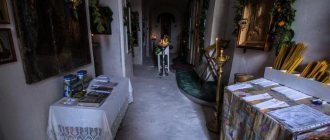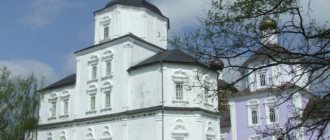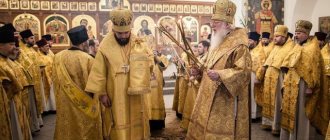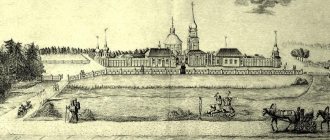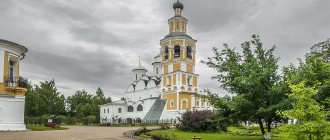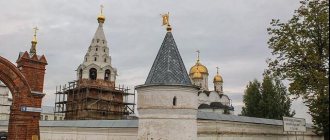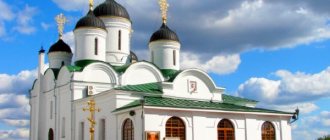Mir
Russia Udmurt Republic St. Tikhvin Monastery (Pazdera) Map is loading...
{"format":"leaflet","minzoom":false,"maxzoom":false,"limit":50,"offset":0,"link":"all","sort":[""], "order":[],"headers":"show","mainlabel":"","intro":"","outro":"","searchlabel":"\u2026 \u0441\u043b\u0435\ u0434\u0443\u044e\u0449\u0438\u0435 \u0440\u0435\u0437\u0443\u043b\u044c\u0442\u0430\u0442\u044b","default":"","import-annotation":false,"width ":"auto","height":"350px","centre":{"text":"","title":"""link":"""lat":56.84352799999999916735760052688419818878173828125,"lon": 53.8557780000000008158167474903166294097900390625,"icon":""},"title":"","label":"","icon":"","lines":[],"polygons":[],"circles":[ ],"rectangles":[],"copycoords":false,"static":false,"zoom":8,"defzoom":14,"layers":["OpenStreetMap"],"image layers":[] ,"overlays":[],"resizable":false,"fullscreen":true,"scrollwheelzoom":true,"cluster":false,"clustermaxzoom":9,"clusterzoomonclick":true,"clustermaxradius":80, "clusterspiderfy":true,"geojson":"","clicktarget":"","showtitle":true,"hidenamespace":false,"template":"","userparam":"","activeicon": "","pagelabel":false,"ajaxcoordproperty":"","ajaxquery":"","locations":[{"text":"\u003Cb\u003E\u003Ca href=\"/palomnik/%D0% A1%D0%B2%D1%8F%D1%82%D0%BE-%D0%A2%D0%B8%D1%85%D0%B2%D0%B8%D0%BD%D1%81%D0%BA %D0%B8%D0%B9_%D0%BC%D1%83%D0%B6%D1%81%D0%BA%D0%BE%D0%B9_%D0%BC%D0%BE%D0%BD%D0 %B0%D1%81%D1%82%D1%8B%D1%80%D1%8C_(%D0%9F%D0%B0%D0%B7%D0%B4%D0%B5%D1%80%D1% 8B)\» title=\»\u0421\u0432\u044f\u0442\u043e-\u0422\u0438\u0445\u0432\u0438\u043d\u0441\u043a\u0438\u0439 \u043c\u0443\u0436\u04 41\u043a\ u043e\u0439 \u043c\u043e\u043d\u0430\u0441\u0442\u044b\u0440\u044c (\u041f\u0430\u0437\u0434\u0435\u0440\u044b)\»\u003E\u0421 \u0432\u044f\u0442\ u043e-\u0422\u0438\u0445\u0432\u0438\u043d\u0441\u043a\u0438\u0439 \u043c\u0443\u0436\u0441\u043a\u043e\u0439 \u043c\u043e\u 043d\u0430\u0441\u0442\u044b \u0440\u044c (\u041f\u0430\u0437\u0434\u0435\u0440\u044b)\u003C/a\u003E\u003C/b\u003E\u003Chr /\u003E\u003Ca href=\"/palomnik/%D0%A1 %D0%B2%D0%BE%D0%B9%D1%81%D1%82%D0%B2%D0%BE:%D0%90%D0%BD%D0%BD%D0%BE%D1%82% D0%B0%D1%86%D0%B8%D1%8F\" title=\"\u0421\u0432\u043e\u0439\u0441\u0442\u0432\u043e:\u0410\u043d\u043d\u043e\u0442\u0430 \u0446\u0438\u044f\»\u003E\u0410\u043d\u043d\u043e\u0442\u0430\u0446\u0438\u044f\u003C/a\u003E: »'\u0421\u0432\u044f\u0442\ u043e-\u0422 \u0438\u0445\u0432\u0438\u043d\u0441\u043a\u0438\u0439 \u043c\u0443\u0436\u0441\u043a\u043e\u0439 \u043c\u043e\u043d\u0430\ u0441\u0442\u044b\u0440\u044c \u043d\u0430 \u041a\u003Cspan class=\"smw-highlighter\" data-type=\"2\" data-state=\"persistent\" data-title=\"\u0418\u043d\u0444\u043e\ U0440 \ U043C \ U0430 \ U0446 \ U0438 \ U044F \ "Title = \" \ U0026#039; \ U0026#039; \ U0026#039; \ U0421 \ U0432 \ U044F \ U04442 LUT 422 \ u0438 \ u0445 \ u0432\u0438\u043d\u0441\u043a\u0438\u0439 \u043c\u0443\u0436\u0441\u043a\u043e\u0439 \u043c\u043e\u043d\u0430\u0441\u0442\u0 44b\u0440\u044c\u043d\u0430\ u041a\u0430\u043c\u0435\u0026#039;\u0026#039;\u0026#039; \u0441\u0442\u0430\u043d\u043e\u0432\u0438\u0442\u0441\u044f \u043c\u0435\u0441\u0442\u043e\u043c \u043f\u0440\u0438\u0442\ u044f\u0436\u0435\u043d\u0438 \u044f \u043d\u0435 \u0442\u043e\u043b\u044c\u043a\u043e \u0432\u0435\u0440\u0443\u044e\u0449\u0438\u0445, \u043d\u043e \u0 438\u0442\u0443\u0440\u0438\ u0441\u0442\u043e\u0432. \u0425\u0440\u0430\u043c \u0422\u0438\u0445\u0432\u0438\u043d\u0441\u043a\u043e\u0439 \u0438\u043a\u043e\u043d\u044b \u0411 \u043e\u0436\u044c\u0435\u0439 \u041c\u0430\u0442\u0435\u0440\u0438 \u0441\u0442\u043e\u0438\u0442 \u0442\u0430\u043c, \u0433\u0434\u0435 \u043a\u043e\u04 33\u0434\u0430-\u0442\u043e \u0431\u044b\u043b\u043e \u0441\u0435\u043b\u043e \u041f\u0430\u0437\u0434\u0435\u0440\u044b. \u0414\u043e \u043d\u0430\u0441 \u0434\u043e\u0448\u043b\u0438 \u0442\u043e\u043b\u044c\u043a\u043e \u043b\u0435\u0433\u043 5\u043d\u0434\u044b\u043e\u043d \u0451\u043c. \u041d\u0430\u043f\u0440\u0438\u043c\u0435\u0440, \u043a\u0430\u043a \u0432 \u0441\u0435\u043b\u043e \u043e\u0434\u043d\u04 30\u0436\u0434\u044b\u043f\ u043e \u041a\u0430\u043c\u0435 \u043f\u0440\u0438\u043f\u043b\u044b\u043b\u0438 \u0438\u043a\u043e\u043d\u044b.\"\u003E\u003 Cspan class=\»smwtext\»\ u003E\u2026\u003C/span\u003E\u003Cspan class=\»smwttcontent\»\u003E»'\u0421\u0432\u044f\u0442\u043e-\u0422\u0438\u0445\u0432\u0438\u043d\ u0441\u043a\ u0438\u0439 \u043c\u0443\u0436\u0441\u043a\u043e\u0439 \u043c\u043e\u043d\u0430\u0441\u0442\u044b\u0440\u044c \u043d\u0430 \ u041a\u0430\u043c\u0435"'\ u0441\u0442\u0430\u043d\u043e\u0432\u0438\u0442\u0441\u044f \u043c\u0435\u0441\u0442\u043e\u043c \u043f\u0440\u0438\u0442\u0 44f\u0436\u0435\u043d\u0438\ u044f \u043d\u0435 \u0442\u043e\u043b\u044c\u043a\u043e \u0432\u0435\u0440\u0443\u044e\u0449\u0438\u0445, \u043d\u043e \u043 8\u0442\u0443\u0440\u0438\u0441 \u0442\u043e\u0432. \u0425\u0440\u0430\u043c \u0422\u0438\u0445\u0432\u0438\u043d\u0441\u043a\u043e\u0439 \u0438\u043a\u043e\u043d\u044b \u0411 \u043e\u0436\u044c\u0435\u0439 \u041c\u0430\u0442\u0435\u0440\u0438 \u0441\u0442\u043e\u0438\u0442 \u0442\u0430\u043c, \u0433\u0434\u0435 \u043a\u043e\u04 33\u0434\u0430-\u0442\u043e \u0431\u044b\u043b\u043e \u0441\u0435\u043b\u043e \u041f\u0430\u0437\u0434\u0435\u0440\u044b. \u0414\u043e \u043d\u0430\u0441 \u0434\u043e\u0448\u043b\u0438 \u0442\u043e\u043b\u044c\u043a\u043e \u043b\u0435\u0433\u043 5\u043d\u0434\u044b\u043e\u043d \u0451\u043c. \u041d\u0430\u043f\u0440\u0438\u043c\u0435\u0440, \u043a\u0430\u043a \u0432 \u0441\u0435\u043b\u043e \u043e\u0434\u043d\u04 30\u0436\u0434\u044b\u043f\ u043e \u041a\u0430\u043c\u0435 \u043f\u0440\u0438\u043f\u043b\u044b\u043b\u0438 \u0438\u043a\u043e\u043d\u044b.\u003C/span\u00 3E\u003C/span\u003E\u043a \u0430\u043a \u0432 \u0441\u0435\u043b\u043e \u043e\u0434\u043d\u0430\u0436\u0434\u044b \u043f\u043e \u041a\u0430\u043c\u04 35\u043f\u0440\u0438\u043f\u043b \u044b\u043b\u0438 \u0438\u043a\u043e\u043d\u044b.","title":"\u0421\u0432\u044f\u0442\u043e-\u0422\u0438\u0445\u0432\u0438\u043d \u0441\ u043a\u0438\u0439 \u043c\u0443\u0436\u0441\u043a\u043e\u0439 \u043c\u043e\u043d\u0430\u0441\u0442\u044b\u0440\u044c (\u041f\u 0430\u0437\u0434\u0435\u0440 \u044b)","link":"","lat":56.84352799999999916735760052688419818878173828125,"lon":53.8557780000000008158167474903166294097900390625, "icon":""}],"imageLayers":[]}
56.843511; 53.854962
Russia, Udmurt Republic, Votkinsky district, Pazdera tract
Udmurt republic
Russia
Telephone:
(8 34145) 7-45-70.
Email:
St. Tikhvin Monastery on Kama
becomes a place of attraction not only for believers, but also for tourists. The Temple of the Tikhvin Icon of the Mother of God stands where the village of Pazdera once was. Only legends about him have reached us. For example, how icons once sailed to the village along the Kama.
History[edit]
Parish Pazdery was opened by decree of the Holy Synod of March 26, 1795. It included villages that were previously part of the parish of the village of Golyany. In 1896, the parish included the villages of Pazdera and Perevoznoye, the villages of Zhuzhgi, Sidorov Gory, Fedotovo (Lapino), Povarenki, Patrakovo, Merzlyaki, Bachino, Severukhi, Olkhovo (Napshi), Leduhi, New Fertiki (Foten), Fomino (Tigi) , Kulyushevo, Pochinok Maksimov. For fifty years the church received its parishioners. Gradually the temple building fell into disrepair. By decree of the Vyatka spiritual consistory of May 20, 1846, due to its dilapidation, it was forbidden to perform divine services in it. In 1846, village residents built a temporary wooden church with one altar. It was consecrated on December 14 in honor of St. Catherine the Great Martyr. In 1855, the village residents built a new wooden church with one altar at the expense of the parishioners. It was consecrated on February 6, 1861 in honor of the Tikhvin Icon of the Mother of God. The church was wooden on a stone foundation, with one dome, a wooden cross and a bell. Children were baptized, married and had funeral services - not a single important event in a person’s life took place without the participation of a priest.
Christians came and came to the Tikhvin Church to venerate the holy icons that sailed on a raft along the Kama River. There was a large square in front of the church. In 1888, a chapel was built near the church, closer to the river. The chapel was wooden, painted white, without a dome. There was a wooden cross on the roof. A chapel is a small church without an altar. The chapel was built on the very spot where the “Old Icons” that sailed along the Kama stopped. Christians built chapels in memory of various events, as well as at holy places - springs, lakes, revered trees, places of “appearance” of miraculous icons. In 1900, another chapel was built at the Pazderinsky cemetery. On July 14, 1913, the foundation of a stone church was laid not far from the temple. But it was not possible to complete its construction.
In 1914, World War I began. Construction was suspended due to lack of funds. Soon the power in the country changed. Permission to continue construction of the temple could not be obtained. The foundation went into the ground. In November 1923, the wooden church burned down from a strong fire. There are several versions of the reasons for the church fire. According to one version, she burned down from a lightning strike. Another reason for the church fire is that the watchman closed the hot stove early and went home. The church burned with a strong but very even flame, without touching the neighboring buildings. After the fire of the church, only one bell, weighing 13 pounds, survived. After the fire, services began to be held in the former church house. This permission was given by Bishop Ambrose of Botkin. The village council charged 14 rubles 59 kopecks monthly for renting a house. Then services began to be held in the chapel.
In 1939, the chapel was closed and services were prohibited due to the dilapidation of the building. But parishioners continued to come to venerate the “Old Icons” and brought offerings: money, scarves, towels, fabric. The children were very interested to see what was in the chapel. They often came and looked into the cracks. In 1952, all the icons, including the “Old Icons,” were moved to the Ascension Church in the village. Perevoznoe. The chapel building was transferred to the village council. The wooden building of the chapel was valued at 50 rubles, and the copper bell weighing 13 pounds was valued at 200. The chapel was closed in winter. The village residents took the icons and organized a religious procession from the village. Pazdery to the village. Perevoznoe. The “Old Icons” were carried especially carefully.
A large, strong village, once sprawling, three kilometers long, inhabiting the Kama coast, was destroyed by the Soviet government under the pretext of flooding these places. Now on the site of the village there are plowed fields and wastelands overgrown with tall grass. Evidence of how houses were located - bushes of raspberries, currants and cherries.
People constantly come and go here, especially in the summer. Some to indulge in fishing, some to gather berries, with which the high bank is generously strewn, and some to get healing water from three non-freezing springs. Such springs usually bubble up where miraculous icons are found, and the water in them is healing. Those in the know say that the water in them has a different taste and helps with all ailments. One of the springs was consecrated by Archbishop Nicholas of Izhevsk and Udmurtia in honor of the Tikhvin Icon of the Mother of God.
Crosses have been erected on the site of the former chapels and churches. The nuns of the Assumption Monastery are praying for the revival of this holy place. And this place is truly holy.
Six years ago, with the blessing of Metropolitan Nicholas of Izhevsk and Udmurtia, a parish was created headed by its chairman, Hieromonk Zosima, whose tasks include the construction of a temple complex with its subsequent re-registration as a monastery. Moreover, official permission for construction was received in August 2008. On the way there were many obstacles, but as Father Zosima says, “with God’s help everything was resolved.” 15 hectares were allocated for the complex, which will include a temple, a monastery, residential buildings, and a vegetable garden. By the way, the design of the temple was based on the sketches of the architect Ivan Charushin (author of St. Michael's Cathedral, Church of the Ascension in the village of Perevoznoe and a number of others).
Not far from the construction site there is a small house; six inhabitants live here and help the builders. Perhaps in the future they will take monastic vows and live here among thirty monks. For the first three years they lived without such a benefit of civilization as electricity - they cooked on the stove, and the rooms were lit with with the help of keratin lamps and candles. And only in 2008, electricity appeared in their small cells. In the summer, the inhabitants cultivate about a hectare of land where they grow vegetables. There is also a spring named in honor of St. Nicholas the Wonderworker. There is also a font here.
In May 2012, the construction of the temple in the non-existent village of Pazdera was completed, and on June 10, 2012, the temple was solemnly consecrated by Metropolitan Nikolai of Izhevsk and Udmurtia.
With the blessing of Archbishop Feognost of Sergiev Posad, Chairman of the Synodal Department for Monasteries and Monasticism, the monastic community of the Church of the Tikhvin Icon of the Mother of God. A commission consisting of the abbot of the Donskoy Monastery, Abbot Paramon, and the abbot of the Nikolo-Ugreshsky Monastery, Abbot Bartholomew, came to Pazdera. The commission gave a positive assessment to the monastic community and in the near future another monastery will adorn the Udmurt land.
To holy places. Tikhvin Monastery, village. Puzzles
Audio |
In 2005, the first workers came to the village forgotten by people. Three years later, electricity appeared here, which means it became possible to begin a large construction project: to build a temple, cells... After 15 years, on November 20, 2021, by decision of the Holy Synod, the male monastic community operating at the parish of the Tikhvin Icon of the Mother of God of the Pazdera tract received official status of the monastery. The program “To Holy Places” continues its journey through Udmurtia.
This is the Kama River, and behind me is a monastic community in honor of the Tikhvin Icon of the Blessed Virgin Mary. Our story today is about this place. Pazdery is the name of the place we came to. In the 16th century it was a palace village, from where fishermen supplied sterlet to the royal court, and in the 70s of the last century it was an unpromising place to live. This is what the Soviet government decided, forcing everyone to leave here.
Monk Ephraim (Mets), resident of the Tikhvin Monastery:
“The residents were told: there will be a release of water into the hydroelectric power station, and you will be flooded, so you must go to larger villages and cities. Part of the village left, and part remained. As a result, in the 80s their electricity was cut off and they were forced to move. These stones are the foundations of houses, found when digging up the earth.
In 2005, people came here to found a monastery where everything had long been overgrown with weeds.
Hegumen Zosima (Sakhipgarayev), Tikhvin Monastery:
“This place looked completely different.” On the left side, where we had the fraternal corps, there was a forest. The place was abandoned: there were a lot of strawberries - lie down and pick them. Here I saw hogweed for the first time in my life. When I saw it, I had an association with America: ancient thickets, grass taller than human height. I served in Perevozny and came to see this holy place. Going down the path and seeing thickets of hogweed, I was surprised that this was the future site of the monastery. But I believed it.
The first thing they built was a polyethylene hut. Workers lived there.
Hegumen Zosima:
– There were no means – just prayer. The morning prayer rule, the evening prayer rule meant that something would happen here. In September we already built a small 5x3 house. It was a great joy for me to move from a tent, where it was already very cold in September, to a house where there was a stove.
Three years later electricity appeared; This means that the construction of the temple could begin.
Hegumen Zosima:
- It's a miracle. I thought: now I’ll do a project, and the money will start pouring in. The money, however, did not pour in. I started asking - no one gives money. Then I began to serve, not paying attention to it, and people themselves began to come, look for and give money.
Now on the Kama you can hear the sound of waves, boats in the distance, and here and there barges, but in the 19th – early 20th centuries there were “singing” steamships here. Pilgrims came to this holy place by river. Once upon a time in Pazderi there was not only a temple, but also two chapels. People greeted the main shrine of these places, the “Old Icons,” with prayerful singing. Now they are in the temple of the neighboring village of Perevoznoye, and once they sailed here along the Kama.
Monk Ephraim:
– There is a legend that they once sailed here along the Kama. Apparently someone got rid of them, but I don’t know for what purpose. Maybe the man, not wanting to burn them, prayed and sent them down the river to God’s will. Once upon a time, during the period of iconoclasm, the Iveron Icon of the Mother of God also sailed to Athos.
And this crucifix was brought to the temple by local fishermen. There is a memory that this happened at half-time of Pentecost after Easter. The crucifixion was revered here as miraculously found.
Local residents especially revered the “Old Icons”: they built a separate chapel for them, saved them from desecration during the revolutionary and Soviet years, and even after the Great Patriotic War the flow of believers to the “Old Icons” did not dry up. What kind of tricks did the authorities go to in order to destroy the crucifix and those to come! The struggle continued until 1978, until the issue was resolved by the Commissioner for Religious Affairs.
Monk Ephraim:
“Local residents, wanting to prevent this, began to write to Moscow. As a result, they ended up in Perevozny. In the 70s, the icons were carried there in a solemn religious procession. According to recollections, the line of people was about five kilometers long.
When people began to settle here again at the very beginning of the 2000s, while struggling with circumstances, they developed a difficult character. The first workers were stern and somewhat unyielding. There were also misunderstandings.
Hegumen Zosima:
“It feels like I’m in a den of robbers.” It began with a conflict on the day of the Kazan Icon of the Mother of God. A week later, the fears passed, and I felt like I was in the right place.
Now most of the territory is plowed into vegetable gardens - the monks eat what they grow themselves.
Monk Ephraim:
“The birds really love all our harvest, but they don’t work.” Our lands are planted with potatoes. I asked Father Peter: “Let’s plant less this time!” No, no! They planted four times more. We promise ourselves every year: “We will plant less!” And we plant more and more.
Every piece of land here has its own history.
Monk Ephraim:
“One of our benefactors brought us carp to eat.” We thought: we need to release them into the pond, which we had just put in order by this time. This is how they live.
Goats, cows, animals that are carefully looked after. Milk is distributed to guests.
Monk Ephraim:
– Out of 365 days, 270 are held in office. In addition, even a big milk lover most often has the habit of drinking skim milk from the store. A person coming to us says that he will drink a lot of milk, and then drinks a glass and cannot drink any more. Even one cow is too much for twelve people, but we have two. That's why we distribute milk.
Interesting story about the tractor. One elderly man says: “I want to give you a tractor. I have money and I’m ready to give it to you.” We agreed with him. He says: “Tomorrow you will come, I will give you money, and you will buy yourself a tractor.” When Father Zosima meets this man, he tells the story: “I just decided to give money the next day, and then I think - it’s a pity. And the amount is large, about 700,000, I don’t want to give it. And I fell asleep with this thought. Suddenly he dreams of his already deceased older brother and says: “What are you doing? Get rid of these thoughts! I decided to give it back!” Such is the story with one of the benefactors.
At the same time, the economy grew, and monastic life was gradually established.
Monk Ephraim:
– At the moment we have six monks, two novices and several laborers. On average, the number of inhabitants is 15 people. Many try themselves for life in a monastery.
There is a font for pilgrims.
Monk Ephraim:
- The history of the font is as follows. Sometimes people who work on shifts in the North come to us. They work for a month or two, then rest for a month or two. Such a shift worker came and built this font alone without assistants. They helped raise the roof, because he physically couldn’t do it alone, but he did everything else himself. Pilgrims bathe all year round; If you feel like it, you can take a dip.
About a kilometer from the monastery there is another holy spring, dedicated to the Tikhvin Icon of the Blessed Virgin Mary. On the day of remembrance of this image, religious processions are held here.
Hegumen Zosima:
– I think that throughout their lives believers should change and not stand still. Everyone has a stage of life into which we enter different. You yourself may not notice, but other people see it. When there was despair, I knew I was on my way. I knew that I was not turning left or right, but going in the right direction. The feeling of reliability has always accompanied me. Even if nothing worked out, there was always hope.
Monk Ephraim:
– First of all, I was attracted by the monastery’s regulations and daily routine. I lived in different monasteries: in the Zaikonospassky Monastery in the center of Moscow, and in a monastery in the field, where no one was allowed at all. Different types of residence – two extremes. In the first there is complete bustle, in the second there is no one at all. There's something in between here. On the one hand there is silence, and on the other there are parishioners and pilgrims who come to worship services on weekends.
Hegumen Zosima:
– All life is built from small cubes - cube by cube. Taking small steps, I don’t immediately see the finished painting or mosaic, but I feel that this is exactly what needs to be done now. Everything doesn't work out right away. We now need to get back on our feet spiritually, create our own community here - a friendly spiritual team.
The monastic community operating at the parish of the Tikhvin Icon of the Mother of God received the official status of a monastery on November 20, 2021 - the Holy Synod of the Russian Orthodox Church decided to open a holy monastery in the Pazdera tract in honor of the Tikhvin image of the Queen of Heaven.
Author and presenter of the program Nadezhda Kalinina
Recorded by Elena Churina
How to get there[edit]
Address:
427412, UR, Votkinsk district, village. Perevoznoe, st. Pazdery, 1.
Telephone:
(8 34145) 7-45-70.
Email:
Directions:
Every Saturday and Sunday a minibus runs from Izhevsk to the monastery and back.
Departure on Saturday from the Druzhba cinema at 5.30
Departure on Sunday from the Druzhba cinema 6.30
Departure from the monastery to Izhevsk 12.00
Registration by phone:
8-922-5000-622 Vladimir
Round trip fare 300 rubles
Assumption Convent (Perevoznoe)[edit]
The official opening of the monastery took place on the feast of the Dormition of the Mother of God on August 28, 1994 in accordance with the Decree of His Holiness Patriarch Alexy II of Moscow and All Rus' and the Holy Synod of the Russian Orthodox Church dated July 18, 1994 on the Blessing for the opening of the Holy Dormition Convent at the Ascension Church in the village. Perevoznoye, Votkinsk district, Udmurt Republic. The monastery was opened in 1994 at the Church of the Ascension, built in the village. Perevoznoe in 1910.
In a short time, monastic and pilgrim cells, refectories, a hotel for pilgrims, and a utility yard were built. The monastic Orthodox tradition of communal life has been revived in the monastery.
In 2007, a wooden Church of the Assumption of the Mother of God was built on the territory of the monastery.
Address:
427412, Udmurt Republic, Votkinsk district, village. Perevoznoe.
Telephone:
8 (34145) 7-45-43
Mother Superior:
Abbess Afanasy (Adamova).
A little history
The monastery was founded in 1993, but believers claim that 350 years earlier its construction was predicted by the Russian saint Tryphon of Vyatka. Several centuries ago he visited these places - preached sermons and healed the sick. Thanks to his appeals to God, a spring appeared at the site of the future monastery, eliminating the infectious eye disease - trachoma.
According to legend, a healing spring appeared in the territory of quarries on the banks of the Cheptsa River. Local residents prepared stones for mills and could not roll off the largest one. Then an old man came to the aid of the tall men - he threw a stone into the water and swam on it against the current. The famous healing spring arose in this place.
In addition, even before the construction of the monastery, in 1888 a small chapel appeared in Kamenny Zadelye, and in 1912 a majestic five-domed wooden church with the throne of the above-mentioned saint was erected.
Malo-Diveevsky Seraphim Convent[edit]
A convent founded in the village of Russky Pychas in 1998 and transferred to Norya in 2001. Cell buildings and a fence were built.
The parish of the village of Bolshaya Norya was opened by decision of the Holy Synod on July 30, 1841. It included villages that were previously part of the parishes of the villages of Puzheuchinskoye and Yuskinskoye: the village of Bolshaya Norya, the village of Yakshur-Norya, the village of Sredny Postol, the village of Stary Postol, the village of Sizyashur-Norya, the village of Kochur-Norya, the village of Vishur-Norya, the village of Pychas, the village Upper Postol, village Kulai-Norya, repair Old Zhenvay, village Verkhnyaya Ludzia, repair Sylshur-Norya. Before the construction of the church was completed, services were held in the prayer house. A wooden church with one altar in honor of the holy chief apostles Peter and Paul was built in 1843 and existed until the completion of the stone church.
Address:
Udmurt Republic, Malopurginsky district, village. Norya, st. Mush, 1.
Holy Intercession Convent (Stone Zadelye)[edit]
The Pokrovsky convent near the village of Kamenny Zadelye, Balezinsky district, became the first monastic monastery in the Glazov diocese of modern times.
The first bishop who came to the Udmurt see after the restoration of the Izhevsk and Udmurt diocese, Palladius (Shiman), thought to found a monastery in this quiet, secluded place for lonely priests who had retired. At first, five nuns who moved from the Vyatka diocese and several novices worked here. The new community in those years lived like the ancient monks: several parishioners of the temple of St. Tryphon of Vyatka, abandoned land around, a lonely priest’s hut, scarcity in everything. In winter it was possible to get here only on skis. We started with the development of the land and the construction of quarters for the nuns.
In 1993, the new Bishop Nikolai (Shkrumko) blessed the construction of the Intercession Convent here.
Address:
Udmurt Republic, Balezinsky district, village. Kamenny Zadelye, lane. Monastyrsky, 2
Directions:
Departure from Balezino to the East, to Kez. 500 m before the Zadelsky cemetery, right turn towards the Cheptsa River. FROM the turn about 500m. From the railway station in Balezino 15 km.
Deposition of the Robe Convent (Luke)[edit]
The Women's Robe Monastery in the village of Lyuk, Zavyalovsky district, opened on August 14, 2021. This was a long-awaited event for the residents of Udmurtia.
The rural church in the name of the Apostles Peter and Paul, under which the monastery was subsequently established, was built in connection with the decree on the opening of an independent parish in the village of Lyuk dated December 13, 1849. The Holy Synod allocated about a dozen villages from the Izhevsk Alexander Nevsky Cathedral Parish to the new parish. In 1850, parishioners built the first wooden church with one altar. In 1863 the building was rebuilt and expanded. In 1867, a parish trusteeship was established, and in 1873, a parochial school. Parishioners of the church in childhood were local natives, the future exarch of Georgia, Archbishop Alexy (Molchanov) and academician-ethnographer Dmitry Zelenin.
Address:
427016, UR, Zavyalovsky district, Lyuk village, Sovetskaya st., 64
Telephone:
8-912-746-94-56 (nun Angelina)
Email:


